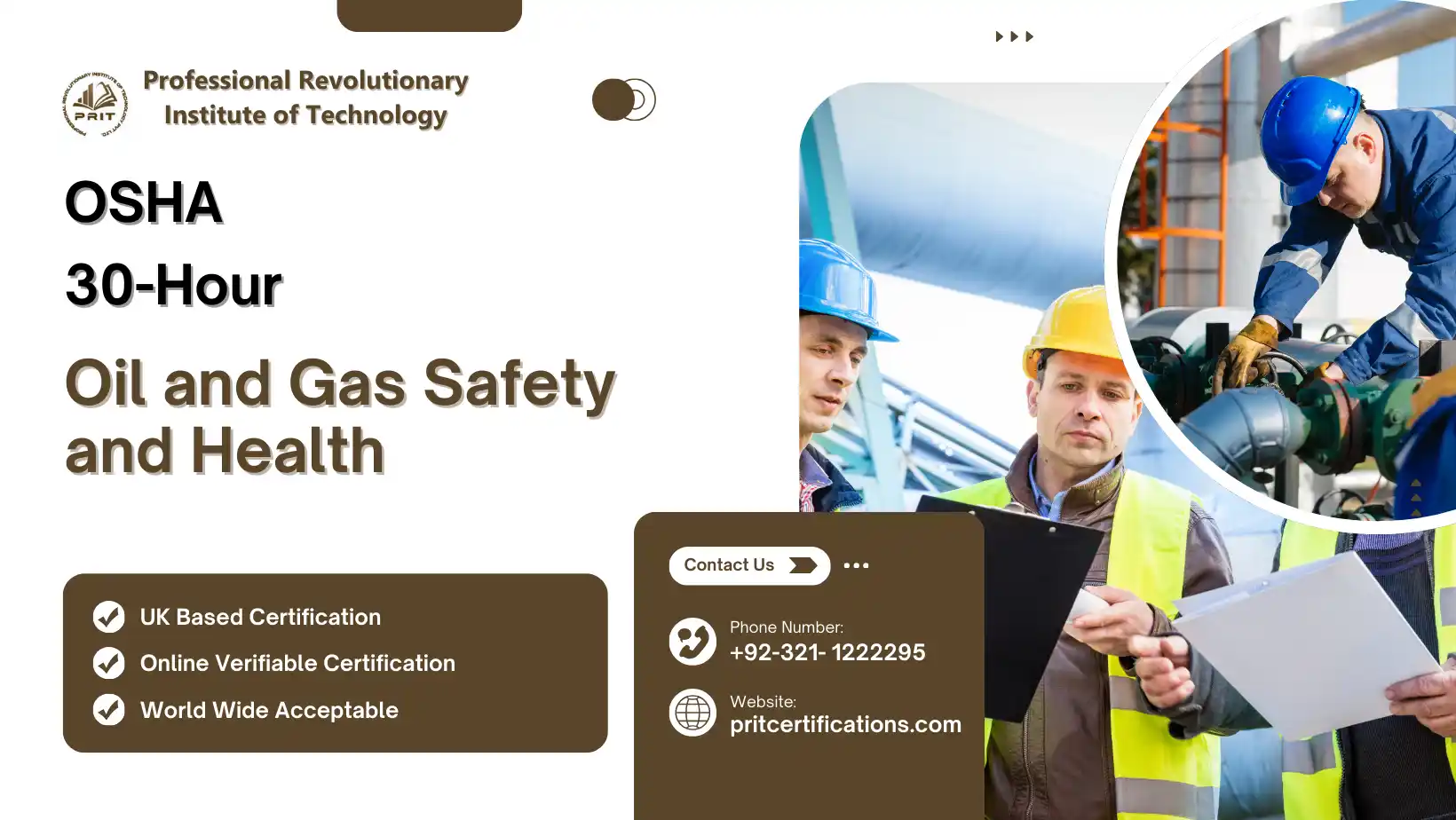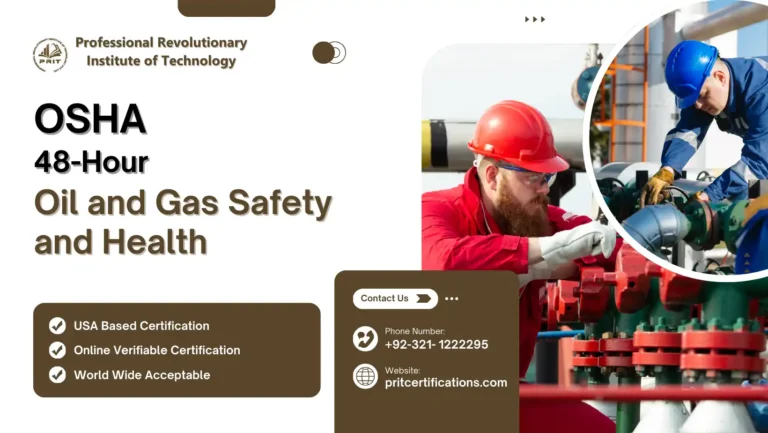
The OSHA 30-Hour Oil and Gas Safety and Health course is designed to provide essential knowledge and practical skills to professionals working in one of the world’s most high-risk industries. The oil and gas sector involves complex operations, heavy machinery, hazardous chemicals, confined spaces, and multiple environmental challenges — all of which require a strong focus on safety and regulatory compliance.
This qualification equips learners with the ability to identify hazards, implement safety controls, and apply OSHA regulations to maintain safe working environments. Covering a wide range of topics such as fire safety, confined space entry, hazard communication, process safety management, and emergency response, the course ensures that participants gain a well-rounded understanding of safety protocols specific to oil and gas operations.
By completing this training, learners will be prepared to create safer workplaces, prevent accidents, and protect both workers and the environment. It is suitable for safety officers, supervisors, engineers, and managers who aim to strengthen their competency in occupational health and safety practices. With a global demand for trained safety professionals, this course opens career advancement opportunities in oil and gas, energy, and related industries.
Course Overview
Qualification Title: OSHA 30-Hour Oil and Gas Safety and Health
Regulated by: OSHA
Guided Learning Hours (GLH): 30 hours
Credits: Equivalent Continuing Education Units (CEUs) recognized internationally
Level: Professional/Industry-Specific Training
Mandatory Units
- Introduction to OSHA and the Oil and Gas Industry
- Respiratory Protection
- Confined Space Entry
- Electrical Safety
- Fire Safety and Prevention
- Safety and Health Programs
- Safety Management Systems
- Hazard Recognition and Control
- Emergency Response Planning
- Personal Protective Equipment (PPE)
- Environmental Safety Practices
- Machine Guarding and Safety
- Process Safety Management (PSM)
- Health Hazards in the Oil and Gas Industry
- Chemical Safety and Hazard Communication
Course Learning Outcomes
Upon completion, learners will be able to:
- Introduction to OSHA and the Oil and Gas Industry
- Understand OSHA regulations and their application to oil and gas operations.
- Recognize key industry hazards and compliance responsibilities.
- Respiratory Protection
- Select and use respiratory protection equipment correctly.
- Implement OSHA respiratory protection standards in workplace scenarios.
- Confined Space Entry
- Apply safe entry procedures for confined spaces.
- Identify and mitigate hazards associated with restricted environments.
- Electrical Safety
- Recognize electrical hazards in oil and gas facilities.
- Implement OSHA standards for electrical safety and lockout/tagout.
- Fire Safety and Prevention
- Apply fire prevention strategies and emergency response measures.
- Conduct fire risk assessments for oil and gas operations.
- Safety and Health Programs
- Develop and manage workplace safety programs.
- Promote a culture of safety within the organization.
- Safety Management Systems
- Implement systematic approaches to managing workplace safety.
- Align safety management with international standards.
- Hazard Recognition and Control
- Identify physical, chemical, and environmental hazards.
- Apply control measures to reduce workplace risks.
- Emergency Response Planning
- Develop emergency response procedures for oil and gas sites.
- Train teams to respond effectively in crisis situations.
- Personal Protective Equipment (PPE)
- Select, maintain, and correctly use PPE.
- Apply OSHA PPE requirements across operations.
- Environmental Safety Practices
- Implement environmental protection practices in oil and gas operations.
- Reduce workplace pollution and ecological risks.
- Machine Guarding and Safety
- Recognize machinery-related hazards.
- Apply OSHA machine guarding standards to prevent accidents.
- Process Safety Management (PSM)
- Understand OSHA PSM standards for handling highly hazardous chemicals.
- Implement systems for preventing catastrophic chemical releases.
- Health Hazards in the Oil and Gas Industry
- Recognize occupational health risks including noise, vibration, and chemical exposure.
- Apply preventive and protective measures to safeguard workers’ health.
- Chemical Safety and Hazard Communication
- Interpret OSHA’s Hazard Communication Standard (HazCom).
- Safely manage, store, and label chemicals used in oil and gas operations.
Entry Requirements
- Minimum age: 18 years.
- Basic literacy and numeracy skills.
- Prior exposure to oil and gas or industrial work is recommended but not mandatory.
- Open to professionals seeking to enhance their safety knowledge and compliance skills.
Course Benefits
- Gain OSHA-recognized certification valued worldwide.
- Enhance workplace safety knowledge specific to the oil and gas industry.
- Reduce workplace incidents and improve compliance with safety regulations.
- Develop leadership and safety management skills.
- Increase employability and career growth opportunities in high-risk industries.
Why Choose This Course?
- Globally recognized OSHA training tailored for oil and gas.
- Comprehensive coverage of critical safety topics.
- Practical and industry-focused learning outcomes.
- Opens career progression pathways in safety management.
- Enhances both individual and organizational safety performance.
Who Can Enroll in This Course?
- Oil and gas industry workers at supervisory or technical levels.
- Safety officers and HSE professionals.
- Engineers, technicians, and managers working in energy sectors.
- Professionals seeking to build safety expertise in high-risk industries.
Future Progression
After completing the OSHA 30-Hour Oil and Gas Safety and Health, learners may progress to:
- OSHA 48-Hour or 155-Hour Advanced Oil and Gas Safety Programs.
- Diplomas and higher qualifications in Occupational Health and Safety.
- Specialized courses in Process Safety, Fire Safety, or Environmental Management.
- Leadership positions in HSE management, consultancy, or compliance.






